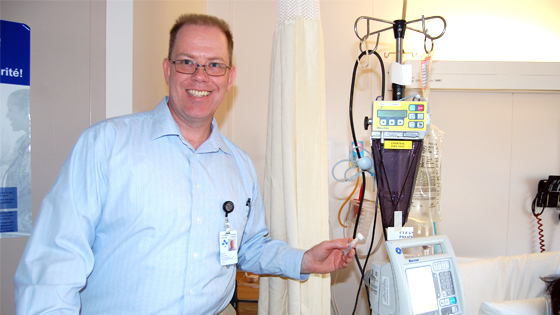
Housekeeping Supervisor David Mullin dabs a fluorescent solution on high-touch areas in patient rooms and washrooms. After the housekeeper cleans, Mullin uses an ultraviolet light to see if all the dab marks were removed.
David Mullin moves around a patient room, shining an ultraviolet light over the high-touch areas such as the light switch, call-bell and bed, searching for any telltale fluorescent residue that wasn’t scrubbed off.
“Patients are very impressed that we’re doing this kind of auditing,” said Mullin, one of the housekeeping supervisors who conduct regular audits. Earlier, he went around the room dabbing a fluorescent solution on the 19 high-touch areas. After the room was cleaned by a housekeeper, Mullin checked to see how well the job was done and entered the data on his iPad.
“They pass 90 percent of the time,” said Housekeeping Manager Julie Lavergne, who reviews the statistics and uses them to re-educate housekeeping staff when needed. “It really shows if someone is disinfecting the high-contact areas, where the transfer of bacteria is most likely to happen.”
If 80 percent of the marks have been thoroughly removed, then the cleaning passes inspection. All remaining marks will be recleaned by the housekeeper. If the room falls below 80 percent, the entire room will be recleaned. Washrooms are similarly marked and inspected; high-touch areas include the flusher handle, dispensers, sink and door handle.
Although these audits have been used for nearly two years, the Housekeeping Department recently changed the cleaning process and implemented a robust reporting system, which has helped to bring down infection rates. Extra audits are added during infectious outbreaks.
Lavergne said the audits are an effective way to monitor and improve cleanliness, and ensure our hospital maintains a clean and safe environment.

Support patient care and research at
The Ottawa Hospital


 To reset, hold the Ctrl key, then press 0.
To reset, hold the Ctrl key, then press 0.